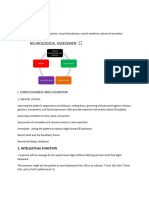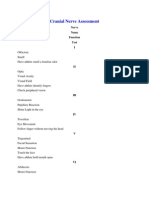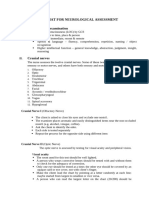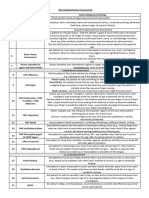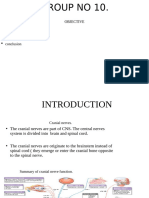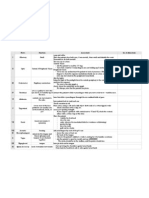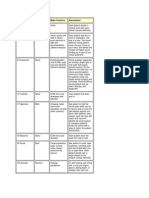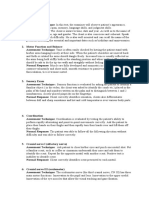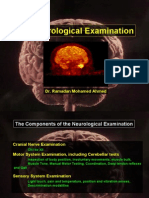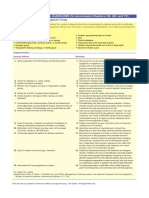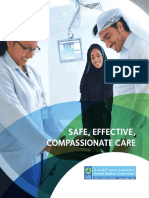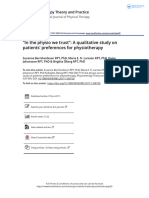0 ratings0% found this document useful (0 votes)
34 viewsAssessing Cranial Nerve Function
Assessing Cranial Nerve Function
Uploaded by
SITTIE JOBAISAH TOMINAMAN ALIThis document outlines procedural guidelines for assessing the 14 cranial nerves. It lists the necessary equipment and provides instructions for testing each cranial nerve, including which movements, sensations or reflexes to observe. Significant clinical findings that may indicate a cranial nerve impairment are described for each nerve assessment. The goal is to perform a thorough cranial nerve exam and identify any abnormalities that could indicate an underlying neurological problem.
Copyright:
© All Rights Reserved
Available Formats
Download as PDF, TXT or read online from Scribd
Assessing Cranial Nerve Function
Assessing Cranial Nerve Function
Uploaded by
SITTIE JOBAISAH TOMINAMAN ALI0 ratings0% found this document useful (0 votes)
34 views1 pageThis document outlines procedural guidelines for assessing the 14 cranial nerves. It lists the necessary equipment and provides instructions for testing each cranial nerve, including which movements, sensations or reflexes to observe. Significant clinical findings that may indicate a cranial nerve impairment are described for each nerve assessment. The goal is to perform a thorough cranial nerve exam and identify any abnormalities that could indicate an underlying neurological problem.
Copyright
© © All Rights Reserved
Available Formats
PDF, TXT or read online from Scribd
Share this document
Did you find this document useful?
Is this content inappropriate?
This document outlines procedural guidelines for assessing the 14 cranial nerves. It lists the necessary equipment and provides instructions for testing each cranial nerve, including which movements, sensations or reflexes to observe. Significant clinical findings that may indicate a cranial nerve impairment are described for each nerve assessment. The goal is to perform a thorough cranial nerve exam and identify any abnormalities that could indicate an underlying neurological problem.
Copyright:
© All Rights Reserved
Available Formats
Download as PDF, TXT or read online from Scribd
Download as pdf or txt
0 ratings0% found this document useful (0 votes)
34 views1 pageAssessing Cranial Nerve Function
Assessing Cranial Nerve Function
Uploaded by
SITTIE JOBAISAH TOMINAMAN ALIThis document outlines procedural guidelines for assessing the 14 cranial nerves. It lists the necessary equipment and provides instructions for testing each cranial nerve, including which movements, sensations or reflexes to observe. Significant clinical findings that may indicate a cranial nerve impairment are described for each nerve assessment. The goal is to perform a thorough cranial nerve exam and identify any abnormalities that could indicate an underlying neurological problem.
Copyright:
© All Rights Reserved
Available Formats
Download as PDF, TXT or read online from Scribd
Download as pdf or txt
You are on page 1of 1
PROCEDURAL GUIDELINES (to accompany Chapter 65)
Assessing Cranial Nerve Function
Equipment • Watch • Ophthalmoscope
• Tongue depressor • Cotton-tipped swab • Samples of familiar odors
• Flashlight • Cotton swabs • Tuning fork
• Sugar and salt samples • Snellen chart • Tubes of hot and cold water
Implementation
Nursing Actions Rationale
1. Explain procedure to patient. 1. Knowledge increases patient comfort and cooperation.
2. Perform hand hygiene. 2. Asepsis is essential to prevent infection.
3. Assess cranial nerve (CN) I (olfactory). With eyes closed, 3. The significant finding is anosmia (loss of sense of smell).
patient is asked to identify familiar odors (coffee, tobacco).
Each nostril is tested separately.
4. Assess CN II (optic). Assess vision using a Snellen eye chart. 4. Significant findings include hemianopias (visual field defects)
Assess visual fields. Perform ophthalmoscopic examination. and decreased visual acuity or blindness.
5. Assess CN III (oculomotor). Test for eye movement toward 5. Significant findings include dysconjugate gaze; gaze
the nose; inspect for conjugate movements and nystagmus. weakness or paralysis; double vision; dilated pupil, with or
Evaluate papillary size, and test for pupillary reactivity to light; without impaired pupillary reaction to light; and inability to
inspect ability to open eyelids. open the affected eyelid.
6. Assess CN IV (trochlear). Test for upward eye movement; 6. Significant findings include dysconjugate gaze, gaze
inspect for conjugate movements and nystagmus. weakness or paralysis, and double vision.
7. Assess CN V (trigeminal). Have patient close the eyes. Touch 7. Significant findings include impaired or absent corneal reflex,
cotton to forehead, cheeks, and jaw. Sensitivity to superficial facial numbness, and jaw weakness.
pain is tested in these same three areas by using the sharp and
dull ends of a broken tongue blade. Alternate between the sharp
point and the dull end. Patient reports “sharp” or “dull” with
each movement. If responses are incorrect, test for temperature
sensation. Test tubes of cold and hot water are used alternately.
While patient looks up, lightly touch a wisp of cotton against
the temporal surface of each cornea. A blink and tearing are
normal responses.
Have patient clench and move the jaw from side to side. Palpate
the masseter and temporal muscles, noting strength and equality.
8. Assess CN VI (abducens). Test for lateral eye movement; 8. Significant findings include dysconjugate gaze, gaze
inspect for conjugate movement. weakness or paralysis, and double vision.
9. Assess CN VII (facial). Observe for symmetry while patient 9. Significant findings include facial weakness, inability to
performs facial movements: smiles, whistles, elevates completely close the eyelid, and impaired taste.
eyebrows, frowns, tightly closes eyelids against resistance
(examiner attempts to open them). Observe face for flaccid
paralysis (shallow nasolabial folds). Have patient extend
tongue. Test ability to discriminate between sugar and salt.
10. Assess CN VIII (acoustic). Perform whisper or watch-tick test. 10. Significant findings include decreased hearing or deafness
Test for lateralization (Weber test). Test for air and bone con- and impaired balance.
duction (Rinne test). Assess balance with eyes open and then
closed for 20 seconds (Romberg test).
11. Assess CN IX (glossopharyngeal). Assess patient’s ability to 11. Significant findings include dysphagia (difficulty swallowing)
swallow and discriminate between sugar and salt on posterior and impaired taste.
third of the tongue.
12. Assess CN X (vagus). Depress a tongue blade on posterior 12. Significant findings include weak or absent gag reflex,
tongue, or stimulate posterior pharynx to elicit gag reflex. Note dysphagia, aspiration, hoarseness, and dysarthria (slurred
any hoarseness in voice. Check ability to swallow. Have patient speech).
say “ah.” Observe for symmetric rise of uvula and soft palate.
13. Assess CN XI (spinal accessory). While patient shrugs 13. Significant findings include weak or absent shoulder shrug
shoulders against resistance, palpate and note strength of and inability to turn the head to the side.
trapezius muscles. As patient turns head against opposing
pressure of the examiner’s hand, palpate and note strength of
each sternocleidomastoid muscle.
14. Assess CN XII (hypoglossal). While patient protrudes the 14. Significant findings include dysphagia and dysarthria.
tongue, note any deviation or tremors. Test the strength of the
tongue by having patient move the protruded tongue from side
to side against a tongue depressor.
Adapted from Bader, M., Littlejohns, L. R., & Olson, D. (2016). AANN core curriculum for neuroscience nursing (6th ed.). Chicago, IL: American Association
of Neuroscience Nurses; Weber, J., & Kelley, J. (2014). Health assessment in nursing (5th ed.). Philadelphia, PA: Lippincott Williams & Wilkins.
From Brunner & Suddarth’s Textbook of Medical-Surgical Nursing, 14th Edition. All Rights Reserved.
LWBK1592-CH65_online-01.indd 1 7/25/17 5:54 PM
You might also like
- Health Assessment ChecklistDocument10 pagesHealth Assessment ChecklistRuby Ann Narvasa100% (1)
- 12 Cranial Nerves and AssessmentDocument10 pages12 Cranial Nerves and Assessmentapollo100% (17)
- Statins News Articles - Worksheet For AQA ScienceDocument3 pagesStatins News Articles - Worksheet For AQA ScienceBen IvesNo ratings yet
- Cranial Nerve AssessmentDocument2 pagesCranial Nerve AssessmentTina RyanNo ratings yet
- HISTORYDocument17 pagesHISTORYAshutosh Shukla T8 407No ratings yet
- WEEK 3 - Head and NeckDocument22 pagesWEEK 3 - Head and NeckHashley CastellyNo ratings yet
- Cranial Nerve Assessment: Nerve Name Function Test IDocument9 pagesCranial Nerve Assessment: Nerve Name Function Test IBecky Mariñas ReducaNo ratings yet
- Cranial Nerve ExaminationDocument3 pagesCranial Nerve Examinationapi-195986134No ratings yet
- Assessment of NeuroDocument38 pagesAssessment of NeuroumairdammarNo ratings yet
- NeurologicalDocument11 pagesNeurologicalHiba V.ANo ratings yet
- CranialNrvDocument20 pagesCranialNrvS ArtNo ratings yet
- Neuro and Cranial Nerve Assessment GuideDocument1 pageNeuro and Cranial Nerve Assessment GuidepriyaNo ratings yet
- Session 4 Skills.......Document18 pagesSession 4 Skills.......Harry ChauhanNo ratings yet
- Nervous System Exam NotesDocument14 pagesNervous System Exam NotesGayathri GellaNo ratings yet
- Module 2 Physical AssessmentDocument8 pagesModule 2 Physical AssessmentMaria EsNo ratings yet
- Cranial Nerves ExaminationDocument25 pagesCranial Nerves Examinationnaveenarageson4No ratings yet
- Canas, Patricia Gan, Razel Ruelo, Vanessa Aquino, Camile Guillano, Christabelle BSN IiiDocument73 pagesCanas, Patricia Gan, Razel Ruelo, Vanessa Aquino, Camile Guillano, Christabelle BSN IiiGan BangNo ratings yet
- Cranial Nerves Examination ChecklistDocument4 pagesCranial Nerves Examination Checklistcontrol the chaosNo ratings yet
- Cranial Nerve Testing Student Guide and RubricDocument8 pagesCranial Nerve Testing Student Guide and Rubricbw653865No ratings yet
- NotesDocument39 pagesNotesfransicomichael17No ratings yet
- Cranial Nerve ExaminationDocument9 pagesCranial Nerve ExaminationKorina AngelaNo ratings yet
- Neurologic System Physical Assessment GuideDocument4 pagesNeurologic System Physical Assessment GuideJeff Shaun Claude PalaparNo ratings yet
- CNS ExaminationDocument59 pagesCNS ExaminationSania ManzoorNo ratings yet
- Cranial Nerve Assessment SheetDocument1 pageCranial Nerve Assessment SheetirmakrsekNo ratings yet
- CRANIALDocument11 pagesCRANIALDemianaNo ratings yet
- Neurological AssessmentDocument76 pagesNeurological Assessmentjcabatit3No ratings yet
- Cranial Nerves AssessmentDocument8 pagesCranial Nerves AssessmentTrisha Najial AlmendraNo ratings yet
- PX NN CranialDocument35 pagesPX NN CranialZenithaMeidaNo ratings yet
- Cranial NervesDocument18 pagesCranial NervesMafisah Rif'atNo ratings yet
- Nerve Classification Major Functions AssessmentDocument2 pagesNerve Classification Major Functions AssessmentMeLissa Pearl GuillermoNo ratings yet
- Exercise 3 - Neuro, Cranial NervesDocument3 pagesExercise 3 - Neuro, Cranial NervesAubrey SungaNo ratings yet
- S14-CN Exam - REVIEW For FINAL-F20-BB-1202Document73 pagesS14-CN Exam - REVIEW For FINAL-F20-BB-1202Michael MerlinNo ratings yet
- PictureDocument11 pagesPictureLaiba FatimaNo ratings yet
- Neurology Text For AssessmentDocument20 pagesNeurology Text For AssessmentVanlalruatfela HmarNo ratings yet
- CN TestingDocument2 pagesCN TestingSandeepNo ratings yet
- Perception and Coordination 2Document58 pagesPerception and Coordination 2Jhensczy Hazel Maye AlbaNo ratings yet
- Heent LabDocument11 pagesHeent Labapi-743783774No ratings yet
- Neurological AssessmentDocument7 pagesNeurological AssessmentSharon LawrenceNo ratings yet
- Test CN I (Olfactory)Document3 pagesTest CN I (Olfactory)frechel kimNo ratings yet
- Kumuthamalar Cranial Nerve Examination (PCM)Document4 pagesKumuthamalar Cranial Nerve Examination (PCM)Andrew MaNo ratings yet
- Cranial Nerve Exam RoutineDocument9 pagesCranial Nerve Exam Routine5kqmn798rfNo ratings yet
- 2 Neurological Assessment ActivityDocument13 pages2 Neurological Assessment Activityapi-688305379No ratings yet
- Osce 2Document5 pagesOsce 2George ahoy100% (1)
- Neurological ExaminationDocument240 pagesNeurological Examinationramadan0% (1)
- EARSEYESDocument93 pagesEARSEYESZen Gesner Kenneth G. EganaNo ratings yet
- Cranial Nerves 1-6Document40 pagesCranial Nerves 1-6joejoNo ratings yet
- Performing Physical Assessment of The EyeDocument14 pagesPerforming Physical Assessment of The Eyezyrine jhen100% (1)
- Task 4 questions -перетвореноDocument12 pagesTask 4 questions -перетвореноAyni SindhiNo ratings yet
- Cranial Nerve ExaminationDocument6 pagesCranial Nerve ExaminationAlthea Aubrey AgbayaniNo ratings yet
- Neurologic System LecutreDocument47 pagesNeurologic System LecutrePauline An Toni CapurihanNo ratings yet
- CNS Cranial NervesDocument4 pagesCNS Cranial Nervesdenise joyce19No ratings yet
- Head + Neck ExaminationsDocument42 pagesHead + Neck Examinationscontrol the chaosNo ratings yet
- Week+1 Cranial+Nerves+Document3 pagesWeek+1 Cranial+Nerves+anapeydsNo ratings yet
- 2 Approach To The Neuro Exam Feb 2011Document35 pages2 Approach To The Neuro Exam Feb 2011suaqaziNo ratings yet
- The Neurological Exam: Respect and Kindness. When You Enter TheDocument9 pagesThe Neurological Exam: Respect and Kindness. When You Enter TheRemelou Garchitorena Alfelor100% (1)
- Assesment of EyeDocument4 pagesAssesment of Eyenafishaasmi002No ratings yet
- Box 10Document2 pagesBox 10stx863No ratings yet
- Health Assessment ChecklistDocument14 pagesHealth Assessment ChecklistLindy Jane100% (1)
- Group 1 Stress Reactions Output 4neDocument20 pagesGroup 1 Stress Reactions Output 4neSITTIE JOBAISAH TOMINAMAN ALINo ratings yet
- Chapter 32 Ingestive DisordersDocument11 pagesChapter 32 Ingestive DisordersSITTIE JOBAISAH TOMINAMAN ALINo ratings yet
- Chapter 14 Electrolyte Imbalances-1Document8 pagesChapter 14 Electrolyte Imbalances-1SITTIE JOBAISAH TOMINAMAN ALINo ratings yet
- Managing Immunoglobulin TherapyDocument1 pageManaging Immunoglobulin TherapySITTIE JOBAISAH TOMINAMAN ALINo ratings yet
- Assisting The Patient Undergoing Thoracentesis PDFDocument2 pagesAssisting The Patient Undergoing Thoracentesis PDFSITTIE JOBAISAH TOMINAMAN ALI0% (1)
- Performing Tracheal Suction-1Document1 pagePerforming Tracheal Suction-1SITTIE JOBAISAH TOMINAMAN ALINo ratings yet
- Behaviour Change For The Health Betterment of The Clients (E.g. Patient Smoking For TheDocument9 pagesBehaviour Change For The Health Betterment of The Clients (E.g. Patient Smoking For TheSITTIE JOBAISAH TOMINAMAN ALINo ratings yet
- COPAR Reviewer LECDocument2 pagesCOPAR Reviewer LECSITTIE JOBAISAH TOMINAMAN ALINo ratings yet
- Setup and Management of Chest Drainage SystemsDocument2 pagesSetup and Management of Chest Drainage SystemsSITTIE JOBAISAH TOMINAMAN ALINo ratings yet
- Performing Nasotracheal SuctionDocument1 pagePerforming Nasotracheal SuctionSITTIE JOBAISAH TOMINAMAN ALINo ratings yet
- Nursing Teaching Plans-1Document4 pagesNursing Teaching Plans-1SITTIE JOBAISAH TOMINAMAN ALINo ratings yet
- WHO On Tuberculosis: Operational HandbookDocument172 pagesWHO On Tuberculosis: Operational HandbookjokonudiNo ratings yet
- Vitamin DDocument3 pagesVitamin DMarion ElliotNo ratings yet
- Acid Base: by Adam HollingworthDocument8 pagesAcid Base: by Adam HollingworthIdrissa ContehNo ratings yet
- Standard ProcessDocument10 pagesStandard ProcessWallace VargasNo ratings yet
- HMC Corporate BrochureDocument37 pagesHMC Corporate BrochureashankarNo ratings yet
- PLANNERDocument4 pagesPLANNERRoland Ceazar CunananNo ratings yet
- De - Mavenclad - Actrims 2024 Cladrina p481Document1 pageDe - Mavenclad - Actrims 2024 Cladrina p481magdecanedaNo ratings yet
- Hunte Et Al 2022 Volumetric Modulated Arc Therapy (Vmat) A Review of Clinical Outcomes What Is The Clinical EvidenceDocument22 pagesHunte Et Al 2022 Volumetric Modulated Arc Therapy (Vmat) A Review of Clinical Outcomes What Is The Clinical Evidencephutycharm15No ratings yet
- Soal Latihan Sumatif Akhir Semester LengkapDocument4 pagesSoal Latihan Sumatif Akhir Semester LengkapFaiz AnkaNo ratings yet
- In The Physio We Trust A Qualitative Study On Patients Preferences For PhysiotherapyDocument16 pagesIn The Physio We Trust A Qualitative Study On Patients Preferences For PhysiotherapyguillaumevbarretteNo ratings yet
- Prescription Regulations Summary Chart (Alberta College of Pharmacists)Document4 pagesPrescription Regulations Summary Chart (Alberta College of Pharmacists)JhunNo ratings yet
- Daftar Pustaka: Chronic Suppurative Otitis Media. AAP News and JournalsDocument2 pagesDaftar Pustaka: Chronic Suppurative Otitis Media. AAP News and JournalsSANG AJI SAMUDRA ANUGRAH 1No ratings yet
- Obstetric History A. Patient'S Profile E. Past Medical and Surgical HistoryDocument1 pageObstetric History A. Patient'S Profile E. Past Medical and Surgical HistoryMaxinne Allyssa Cancino RoseñoNo ratings yet
- Physical GrowthDocument11 pagesPhysical GrowthAbdulrahman AlsulimaniNo ratings yet
- VVM 3Document6 pagesVVM 3varadasakore031No ratings yet
- Functional Endoscopic Sinus SurgeryDocument11 pagesFunctional Endoscopic Sinus SurgeryIrene Natalia SihombingNo ratings yet
- Basal Bolus InsulinDMT22009Document92 pagesBasal Bolus InsulinDMT22009scribdNo ratings yet
- Cardio Sample ReportDocument2 pagesCardio Sample Reportprudhvirajthota4No ratings yet
- Hydrogen Peroxide Final 2020 11Document30 pagesHydrogen Peroxide Final 2020 11Apurva PathakNo ratings yet
- Pharm MCQ BookDocument11 pagesPharm MCQ BookanojanNo ratings yet
- 1: Schizoprhenia Spectrum Disorder: Sazon, Marva Therysse A. Psych 136 - Abnormal Psychology Bs Psychology FinalsDocument37 pages1: Schizoprhenia Spectrum Disorder: Sazon, Marva Therysse A. Psych 136 - Abnormal Psychology Bs Psychology FinalsMARIE ROSE L. FUNTANARNo ratings yet
- Dokumen - Tips Airway SuctioningDocument27 pagesDokumen - Tips Airway SuctioningNursep DeWitaNo ratings yet
- Risk Management in EndodonticsDocument39 pagesRisk Management in EndodonticsDrSree KanthNo ratings yet
- Tratado de Psicofarmacologia PDFDocument20 pagesTratado de Psicofarmacologia PDFNsndndfkNo ratings yet
- Estimating The Post-Mortem Interval at The SceneDocument10 pagesEstimating The Post-Mortem Interval at The SceneEmma MarelliaNo ratings yet
- PER-PL 206 (Pin. 1/2003) : District/State For The Month March 2023Document15 pagesPER-PL 206 (Pin. 1/2003) : District/State For The Month March 2023Melvin EdwardNo ratings yet
- Microorganisms 12 00024 v2Document28 pagesMicroorganisms 12 00024 v2istuti saraswatNo ratings yet
- SauFRa Technique For The Fixation of Resorbable Membranes in Horizontal Guided Bone RegenerationDocument5 pagesSauFRa Technique For The Fixation of Resorbable Membranes in Horizontal Guided Bone RegenerationSchwan AbdulkareemNo ratings yet
- Organ TransplantationDocument36 pagesOrgan TransplantationAnonymous 4TUSi0SqNo ratings yet




